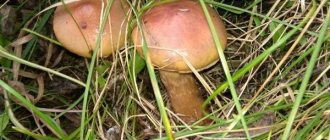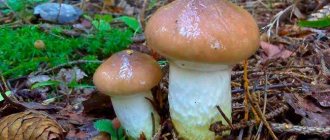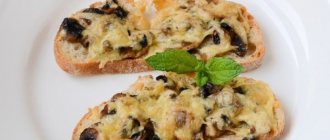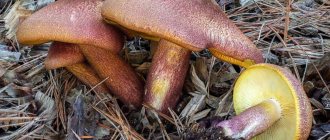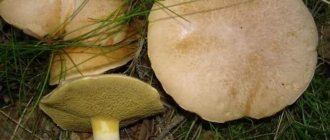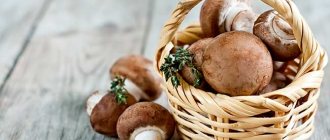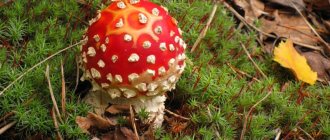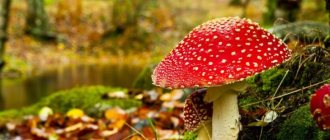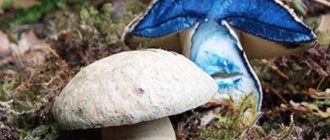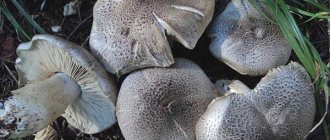What kind of mushrooms do you come across while walking through the forest: poisonous, edible, neutral…. All of them certainly attract the attention of mushroom pickers.
However, against the backdrop of bright porcini mushrooms, chanterelles, boletus, boletus, toadstools and fly agarics, there are completely nondescript caps that are unlikely to catch anyone’s eye. However, a nondescript mushroom does not mean that it is tasteless. This happened with the purple moth or, as it is also called, pine. This mushroom easily hides under fallen spruce needles and is practically invisible on wet ground. However, if you are lucky enough to collect it, you should know that a delicious dinner awaits you, since mokrukha is an edible mushroom, in addition, it has good taste and carries many benefits. We will talk about this in more detail in the article.
What do purple mokrukha mushrooms look like?
Purple moth, also known as pine moth or yellowleg, belongs to the Boletaceae order and the Mokrukhov family, and has a fairly recognizable appearance.
The photo of the purple moth shows that its cap is relatively small, from 4 to 8 cm in diameter, at a young age it is round, convex and with a characteristic blunt tubercle in the middle, and in an adult it is spread out or even concave. The surface of the cap is smooth, in wet weather it becomes covered with a mucous coating, the color is very unusual, brownish-lilac or with a reddish wine tint. The bottom surface of the cap is covered with wide thin plates, pinkish-purple in young mushrooms, and dirty brown, sometimes almost black, in adults.
The leg of the purple moth is thin, rises up to 10 cm above the ground, is often curved and usually tapers slightly towards the base. The color of the leg is the same shade as the cap, but remains a little lighter. The structure of the stem is silky to the touch; often you can see the remains of a covering on it, especially in young fruiting bodies.
If you cut the purple mocha, the flesh of the cap will be dense and mauve, with a neutral smell and taste. The leg is lilac-red when cut, and yellow at the very base.
Definitioner
Basidia (Basidia)
Lat. Basidia. A specialized structure of sexual reproduction in fungi, unique to basidiomycetes. Basidia are terminal (end) elements of hyphae of various shapes and sizes, on which spores develop exogenously (outside).
Basidia vary in structure and method of attachment to hyphae.
Based on the position relative to the axis of the hyphae to which they are attached, three types of basidia are distinguished:
Apical basidia are formed from the terminal cell of the hypha and are located parallel to its axis.
Pleurobasidia are formed from lateral processes and are located perpendicular to the axis of the hypha, which continues to grow and can form new processes with basidia.
Subbasidia are formed from a lateral process turned perpendicular to the hyphal axis, which stops growing after the formation of one basidium.
Based on morphology:
Holobasidia are single-celled basidia, not divided by septa (see Fig. A, D).
Phragmobasidia are divided by transverse or vertical septa, usually into four cells (see Fig. B, C).
By type of development:
The heterobasidium consists of two parts - the hypobasidium and the epibasidium developing from it, with septations (see Fig. C, B) or without them (see Fig. D).
Homobasidia is not divided into hypo- and epibasidia and in all cases is considered to be holobasidium (Fig. A).
The basidium is the site of karyogamy, meiosis, and the formation of basidiospores. Homobasidy, as a rule, is not functionally divided, and meiosis follows karyogamy. However, the basidia can be divided into probasidium, the site of karyogamy, and metabasidium, the site of meiosis. Probasidium is often a resting spore, for example in rust fungi. In such cases, the probasidium germinates into a metabasidium, in which meiosis occurs and on which basidiospores are formed (see Fig. E).
See Karyogamy, Meiosis, Hypha.
PileipellisLat. Pileipellis, skin - a differentiated surface layer of the cap of agaricoid basidiomycetes. The structure of the skin in most cases differs from the inner flesh of the cap and may have a different structure. The structural features of pileipellis are often used as diagnostic characters in descriptions of fungal species.
Based on their structure, they are divided into four main types: cutis, trichoderma, hymeniderma and epithelium.
See Agaricoid fungi, Basidiomycete, Cutis, Trichoderma, Hymeniderma, Epithelium.
Pileipellis (Pileipellis)
Lat. Pileipellis, skin - a differentiated surface layer of the cap of agaricoid basidiomycetes. The structure of the skin in most cases differs from the inner flesh of the cap and may have a different structure. The structural features of pileipellis are often used as diagnostic characters in descriptions of fungal species.
Based on their structure, they are divided into four main types: cutis, trichoderma, hymeniderma and epithelium.
See Agaricoid fungi, Basidiomycete, Cutis, Trichoderma, Hymeniderma, Epithelium.
Amyloid (Amyloid structure)
The structure is called amyloid if the Meltzer reagent (solution of 0.5 g of crystalline iodine + 1.5 g of potassium iodide + 20 ml of chloral hydrate + 20 ml of distilled water) turns blue, violet, and sometimes almost black.
See Dextrinoid structure.
Where do pine moths grow?
Purple mokrukha is not the most common mushroom in Russia. However, you can see it throughout almost the entire country - in the middle zone, in the Caucasus and Crimea, even in Siberia. Most often, yellowlegs grows on calcareous soils in coniferous and mixed forests. It is sometimes found on hills, but usually forms a symbiosis with birch or pine trees.
Purple moth grows both singly and in groups. It is often found not far from boletus, as it chooses similar habitats.
Bibliography
- Aurel Dermek. Mushrooms. - Bratislava: Slovart, 1989. - pp. 140-141.
- Z.A.Klepina and E.V.Klepina. Mushroom Picker's Guide. - Moscow: AST-PRESS, 2006. - 256 p. (pp. 60-61).
- "Mushrooms. Directory-determinant. More than 120 species” / Author-compiler N.E. Makarova - Moscow: AST, Minsk: Harvest, 2005 - 320 p. (pp. 202-203).
- "Mushrooms". Directory. / lane from Italian F. Dvin - Moscow: AST. Astrel, 2004. - 303 p. (p. 201).
- Lesso, Thomas. Mushrooms. Determinant. / lane from English - Moscow: AST, 2007. - 304 p. (page 37).
Benefits and harm to the body
The popularity of purple mokrukha in cooking is due not only to its taste. Yellowlegs can provide great health benefits due to its valuable chemical composition. Its pulp contains the following substances:
- vitamins B2, B1 and E;
- ascorbic acid;
- vitamin PP;
- cellulose;
- a large amount of high-quality vegetable protein;
- amino acids;
- organic acids and enzymes;
- potassium and iron;
- calcium, phosphorus and manganese.
With good nutritional value, yellowleg is very low in calories and contains only 19 kcal per 100 g of pulp, so it is found in many diets.
Eating purple moth has a beneficial effect on the body because the product:
- strengthens the immune system and improves the functioning of the metabolic system;
- helps relieve inflammation and fight infections;
- has a calming and relaxing effect;
- has a positive effect on the muscular system;
- promotes cell renewal;
- improves the condition of skin and hair;
- has a good effect on blood vessels and protects the heart from the development of chronic diseases;
- strengthens memory and improves brain function.
Despite its many beneficial properties, purple mocha has some contraindications. First of all, it is not recommended for pregnant women and nursing mothers to eat it. Yellowlegs should not be offered to young children under 7 years of age; any mushroom pulp is poorly absorbed by their bodies due to its high protein content.
Advice! You should also avoid purple yellowlegs if you have an individual intolerance to mushrooms, or with chronic ulcers and pancreatitis. The protein-rich product can slow down digestion, so you should eat it with caution if you have frequent constipation.
Application in cosmetology
The beneficial properties of mokrukha can be used for cosmetic purposes. Mushroom-based preparations maintain skin elasticity and have a moisturizing effect, help avoid the formation of wrinkles, eliminate inflammation and rashes on the face. You can add mokrukha pulp or dry powder to regular care creams or homemade masks based on oils and fermented milk products.
We recommend reading: Lupine (lupine): benefits and harm to humans, magical properties
A decoction of the mushroom can be used to rinse hair. The product helps well with increased oiliness of hair and dandruff, as it cleanses the scalp and returns a healthy shine to the strands.
False doubles
The purple fly has no poisonous or hazardous counterparts. But in the absence of experience, it can easily be confused with edible mushrooms of the same species.
Spruce fly
This mushroom is very similar in structure to the purple variety. His hat is also medium in size, first convex and then spread out, the leg reaches 12 cm in height and 2.5 cm in girth. But you can distinguish the spruce mushroom by the shade of its color; its cap is gray or gray-violet; it does not have an unusual wine tint.
In accordance with its name, spruce fly grows mainly in spruce forests and forms a symbiosis with spruce trees. You can eat it, but its taste is rather average.
Pink wee
Another variety similar to the photo of pine moth is the pink moth. Mushrooms are united by similar structural features - strong cylindrical legs, narrowed at the bottom, and convex caps at first, and later spread out caps. But the differences between the varieties are noticeable - the pink fly is much smaller and rarely exceeds 5 cm in diameter. In addition, its cap is bright pink when young, while on old fruiting bodies it has a slight yellowish tint and dark brown spots.
Pink moths grow in coniferous forests, mainly in the mountains, and are often found next to goats. The mushroom is not widespread and is quite rare. Like purple moth, it is classified as edible, but has a mediocre taste and requires peeling before consumption.
Healing properties
Yellowlegged moth is the absolute champion in terms of the amount of nutrients and amino acids. It contains:
- Vitamin C. Its deficiency manifests itself in tooth loss, heart weakness, and fatigue. It strengthens the immune system and improves performance.
- Riboflavin. Its deficiency can cause eye diseases and hair loss. Vitamin B2 plays an important role in enriching cells with oxygen.
- Thiamine. This vitamin regulates metabolic processes, the functioning of the heart and blood vessels, and affects the activity of the nervous system.
- Vitamin E. Increases libido, promotes successful conception and pregnancy.
Traditional healers use this mushroom to prepare ointments that are used to treat neurogenic and common dermatitis. The product is made from alcohol.
The principle of preparing the medicine is the same as for the red fly agaric ointment:
- It is necessary to chop the caps of 10 mushrooms and place them in a 1 liter container.
- Then you should close it tightly with a lid and leave it in a warm place for 3 days.
- After the passed interval, the mokrukha must be filled with moonshine or alcohol to the top so that a layer of liquid of 1 cm forms above them.
- The container must be sealed again and left for a month.
The resulting composition is lubricated on the skin using a cotton pad. This should be done at night. The ointment is stored for no more than 3 years in a dark place.
Collection rules
You need to go into the forest for purple moths during the period of maximum fruiting, from August to the end of September. It is best to choose days after prolonged rains; in wet weather, fruiting bodies grow especially quickly and en masse.
Purple moths should be collected in clean places located away from cities, industrial facilities, railways and highways. Since the mushroom pulp absorbs all the toxic substances from the ground and air, yellowlegs collected in environmentally unfavorable areas will not be able to provide health benefits.
Possible contraindications
There are no complications associated with taking mucus as food or as an additive to medicines and cosmetics. The purple tint of the color helps prevent the purple moth from being confused with any other poisonous mushroom. When cut, this type of mushroom always takes on a pink or red color. However, even the most harmless mushroom at first glance can have negative consequences on the human body. This can happen if the mushrooms were collected in the forest near highways, within the boundaries of a large city, near industrial enterprises or landfills. Such mushrooms should not be collected and eaten.
For some people, mushroom food may be too heavy and their body will have difficulty digesting the product. These groups of people include children, the elderly and people suffering from diseases of the gastrointestinal tract. Chitin, which mushrooms contain, is practically not absorbed by an unprepared child’s body.
spruce moth - description of where it grows, the toxicity of the fungus
Recipes for making purple mokrukhs
Purple mokrukha is suitable for almost any cooking method. But before frying, pickling or otherwise preparing purple moth, does it need to be pre-treated?
- Fresh fruiting bodies must be prepared within 24 hours after collection; they are not stored for long and quickly begin to deteriorate.
- Before cooking, the mucous film on the cap must be removed from the yellowlegs, and then rinsed in cold water.
Important! There is no need to soak purple mushrooms; unlike many other mushrooms, they can be immediately subjected to further heat treatment.
Boiled mokruhi
The fastest way to cook autumn yellowlegs is to simply boil it in salted water. The peeled and washed caps and legs are placed on the stove and boiled for only 15 minutes. The water is then drained, and after cooling the mushrooms are added to the salad, eaten as a snack, or subjected to further processing.
Fried mokruhi
Yellowlegs fried with potatoes, meat or vegetables can delight you with a pleasant taste. The boiled caps and legs are placed in a frying pan greased with vegetable oil and fried along with onions or chopped potatoes for as long as necessary until the side dish is fully cooked. There is no need to check the yellowlegs themselves; they do not require long frying using special technology.
Salty mokruki
The classic method of preparation is cold pickling of purple mushrooms, which allows you to preserve mushrooms for the winter. The recipe looks very simple - pre-boiled caps and stems are placed in layers in a sterile glass jar. Each layer should be generously sprinkled with salt; you can also add spices to the pickling, for example, dill seeds and pepper, garlic and cloves.
The filled jar is covered with folded gauze along the neck and pressed down with pressure. After a few days, the mushrooms should completely cover the released juice, and after another 40 days, the pickles become ready to eat. During the salting process, the gauze on the neck of the jar needs to be changed from time to time to prevent mold from growing on it.
Contraindications
Despite the fact that moth is absolutely harmless and even edible, there are still some precautions that are important to follow.
- So, first of all, we do not recommend pregnant women to eat spruce moth.
- Also, it is recommended that children also avoid eating this mushroom.
- People who have diseases of the gastrointestinal tract or kidney failure should be careful when handling mushrooms.
- It is worth refusing to eat mushrooms that grew in areas that are located near highways, as well as industries.
Purple weed is the perfect mushroom to add to your dinner. It is tasty, pleasant, and, most importantly, healthy for your body. However, the beneficial properties of the mushroom can only appear if you are absolutely healthy, and most importantly, if you followed the rules when collecting this mushroom.
If you are lucky enough to collect a whole basket of mokrukhs, know that they can be used in many ways.
(
1
ratings, average:
5,00
out of 5)
Loading…
Nutritional value and composition per 100 g
Any mushroom contains in its pulp a lot of usefulness that can replace the daily intake of meat. Mokrukha is no exception to the rule! 100 g of product contains:
- about 20 kcal;
- protein;
- fatty amino acids;
- carbohydrates;
- vitamins PP, C, B1 and B2, E.
Increased value - ideal for use during dieting and fasting, which reduces daily calorie intake.
Growing methods
At home, moths are grown by sowing their mycelium. the acquired mycelium is mixed with 0.5 kg of dry soil or sand. Before planting, depressions of about 10 cm are made in the ground. The mycelium is evenly distributed over the surface (use 1 package per 1 m2). The area is sprinkled with soil mixed with compost at a ratio of 1:1. Pine needles are also used for shelter.
Irina Selyutina (Biologist):
Purple moth should be planted next to a pine tree, because Mycorrhiza is forming with this tree species. A circular hole is dug around the tree with an average depth of 10 cm (5-15 cm, it all depends on the depth of the roots at the soil surface). After this, the mixture of mycelium and sand is evenly distributed throughout the entire hole. The mycelium will grow for a long time - as long as your pine tree will live. During the period when mushrooms are not growing, it is advisable to sprinkle a uniform layer of humus on top of the planting site at the rate of 15 kg/m2.
You can try to grow mokrukha indoors, as is done with champignon. However, the results will be much worse, because the probability of mycelium germination is significantly reduced.
Water 10 liters of water per 1 m2 once a week. Purple weed gives a harvest 4 times a year, the first harvest is carried out 2 months after sowing. If mushrooms do not grow well, it will be useful to add humus at the rate of 10 kg per 1 m2. Pine needles are also used for shelter.
Autumn honey fungus, or true honey fungus (Armillaria mellea)
Season: August-November.
Autumn honey fungus, or real
Habitat: coniferous and mixed forests, on coniferous wood, stumps, fallen trees. They grow in huge groups. One of the most favorite mushrooms.
Description of the species:
- the cap is 3-10 cm in diameter, at first round-convex, later spread out, sometimes with a tubercle in the middle. A distinctive feature of the species is its yellow-brown or brown-reddish cap with numerous small brown scales. The edges of the cap are striped, first curled inward, later straightened out. In young specimens, the cap is connected to the stalk by a white membrane, which later remains in the form of a ring in the upper part of the stalk;
- the stalk is 4-12 cm high and 6-15 mm thick, dense, cylindrical, at first flocculent-scaly, later almost bare, slightly widened near the base. In the upper part of the leg there is a well-defined ring with a fringed edge. The stem is usually exactly the same color as the cap;
- the pulp is dense, white, does not change color when broken, with a pleasant smell and taste;
- the plates are sparse, adherent, slightly descending along the stalk, thin, frequent, whitish-yellowish in young specimens, brownish in maturity, often covered with rusty spots.
Variability: the cap can be light (yellow-brown) in dry weather, but in damp and cold weather its color darkens (to dark brown).
Similarity with other species: autumn honey fungus is similar to the inedible honey fungus (Hypholoma capnoides), which is distinguished by very frequent plates of grayish or gray-brown color.
Hypholoma capnoides
It also looks like brick-red honey fungus (Hypholoma sublateritium) with frequent olive-brown plates with a purple tint.
Brick red honey fungus (Hypholoma sublateritium)
Edibility: edible, classified as category 3.
Cooking methods: frying, marinating, boiling.
All species of the genus Chroogomphus:
| Purple moth (Chroogomphus rutilus) | Tomentosweet (Chroogomphus tomentosus) |
Purple moth (Chroogomphus rutilus)Felt moth (Chroogomphus tomentosus)
TOP
If you doubt the edibility of the mushrooms you find, do not take them. The site administration does not bear any responsibility for the actions of people taken on the basis of information received on the site. Some types of poisonous mushrooms cannot be identified without special equipment and can be confused with edible ones. For all questions related to the operation of the site, please contact the administration mailbox Copyright ©2016 - 2020
